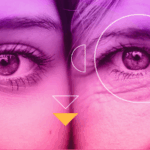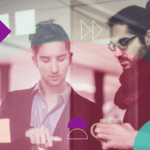It’s easy to recognize that the world has transformed significantly in recent years: consumer behaviors have shifted online and brands’ investments in digital have rapidly accelerated. And in the center of both trends sits the agency partner, whose job is to connect brands with their audiences everywhere they show up. But amidst an era of incredible change, why has the brand-agency relationship largely stayed the same?
In a panel discussion on brand-agency relationships at Advertising Week New York, Media.Monks Founder Wesley ter Haar, S4Capital Chairman Sir Martin Sorrell, and Mondelēz’s Global Head of Agency Ecosystem – Consumer Experience Meghan Johnson met to discuss how Mondelēz and Media.Monks have come together to help the global snacking giant satisfy cravings everywhere. The discussion served key insight into the challenges and goals of global FMCG brands, and how partners must evolve to better suit their needs.
Inside the New Partner Model
Early in the panel discussion, Sir Martin summed up the strategy that guides Media.Monks’ approach to partnership. “Our mission is to create the new age/new era marketing services model and disrupt the old.” This takes shape in four ways: placing a focus on digital; enabling personalization at scale fueled by data-driven insights; understanding the digital ecosystem to move at speed; and perhaps most importantly, showing up as a unitary brand. “We’re building a network from the bottom up,” Sir Martin added. “We’re in the business of making things, and that’s at the core—we create and make things and build up from there.”
Before the launch of Media.Monks’ unitary brand, the company’s unique ability to bring data, digital media and content together proved essential to cementing the relationship with Mondelēz, for whom Media.Monks manages tech infrastructure, global websites and content production in North America, Latin America, Asia, the Middle East and Africa. “When you’re trying to destroy legacy thinking and legacy ways of doing, you look for simple solutions,” says Johnson. “Strategically it’s better for us as clients to have that one door into best-in-class capabilities. Operationally it makes a whole lot of sense for [Media.Monks] from a back-end perspective.”
Mondelēz is one of the world’s largest snack companies, with nine global-leading brands, more than 60 region-favorite brands and a presence in over 150 countries. This dizzying combination of brands and markets creates a natural complexity that many global FMCG brands must navigate to meet audiences with efficiency and effectiveness. Johnson notes that close partnership is essential to overcoming these challenges and better meeting consumer needs. “We see our competitive advantage in treating our agencies as strategic partners, not vendors, and using their nimbleness as speedboats to test new capabilities,” she says.
Building a System for Speed and Scale
When it comes to closer collaboration with brands like Mondelēz, Media.Monks eliminated the barriers typically encountered within the traditional agency model. “The irony of networks is they do not have a network effect,” says ter Haar. “There are foundational complexities to the network model that make it almost impossible for teams and talent to operate and organize seamlessly around what clients actually need.” Media.Monks’ API-inspired model seamlessly connects teams and offers brands access to a diverse pool of talent and skill sets at an arm’s length.
In addition to talent access, the API model is also built as a system for scale. It enables new businesses that join Media.Monks to have the space to grow and organically expand capabilities for brands around the world. “We want companies to join us and have an ownable space, a node within the API,” says ter Haar. “We say, ‘Come scale your superpower.’ They have something they can own and scale.”
The recent addition of Zemoga to Media.Monks’ team showcases this approach in action by fortifying the technology services pillar in its remit. And by aligning content, data&digital media and technology within a single team, we’re better able to connect the dots with stakeholders across a client’s business. “When we started in May 2018, we talked about digital transformation from the marketing and sales point of view,” says Sir Martin. “Effectively, now we have the full set: we can approach the digital marketing transformation process through the marketing function, through the sales function, through the IT function.”
All three verticals are key, but legacy systems—both within a brand or its agency partners—can make this level of connection tough to achieve. The API model is an antidote that aims to bring each together to maximize effectiveness across the business and consumer journey.
Toward New Forms of Storytelling
The ability to show up meaningfully across the digital ecosystem has become critical for brands like Mondelēz as they adapt to shifts in consumer expectation. Johnson defined the three needs that she thinks storytelling should fulfill. First, it’s empathetic—it needs to mean something to the audience. Second, it needs to feel authentic in the context of where you tell it. “A story on TikTok is going to look and feel a lot different than what you see on YouTube,” she says. And third, it should be simple.
“As marketers, we usually do the first two parts well, and fall apart on the simplicity piece,” says Johnson. “We’re still so enamored by a great 30- or 60-second spot, but we forget it’s not where we spend our money anymore and it’s not where consumers spend their time.” Brands need new storytelling and creative techniques in the form of fit-for-format content and experiences that extend across channels—but legacy roadblocks can often inhibit creative’s effectiveness across a range of channels.
For ter Haar, the solution lies not only in new ways of thinking. “We talk a lot to clients about ‘feeding the feeds,’ being hyper aware of where people are spending their time,” he says, noting that telling great stories shouldn’t be limited to a linear, traditional format. “I think seeing that not as a restriction, but as an opportunity, is really the mindset shift.”
While the need to meet consumers authentically across channels has existed for years, it was during the height of the pandemic that investments in digital accelerated—a trend that shows no signs of subsiding. “I think within companies, the change agents will be given even more oxygen in 2023,” says Sir Martin, anticipating greater transformation on the horizon.
As new channels and behaviors continue to challenge traditional ways of thinking and doing, brands will need to keep up—and so will their partners. Whether by aligning business stakeholders planning the next step in digital transformation or by breaking big ideas down into fit-for-format creative opportunities, it’s time for the brand-agency relationship to evolve—and we’re thankful for brands like Mondelēz who have joined Media.Monks on a journey to better ways of working.






